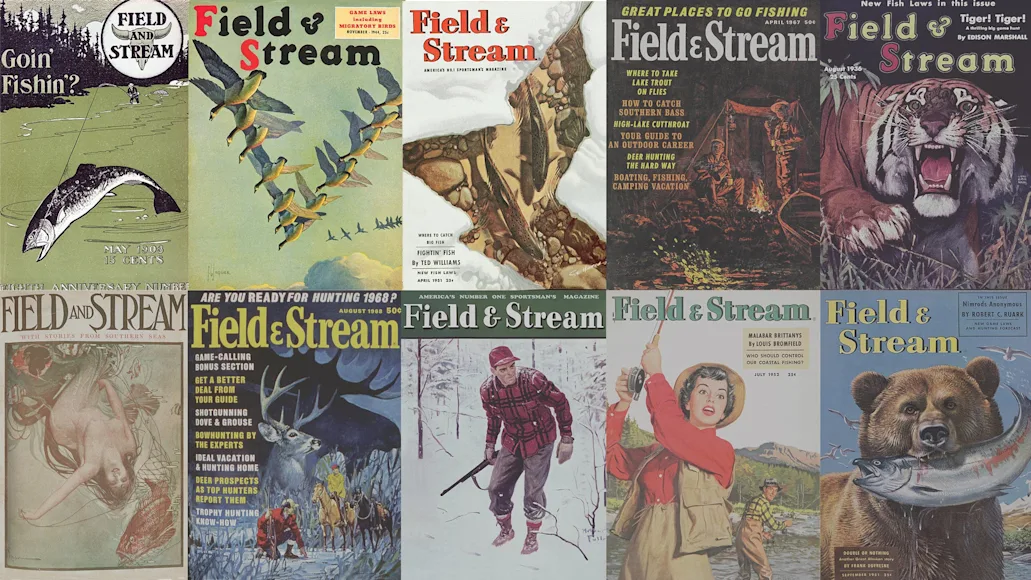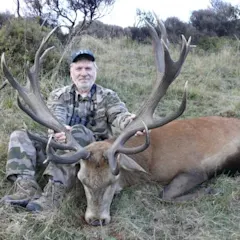For more than 100 years Field & Stream has been the wellspring of hunting and fishing knowledge. Since our wisdom is boundless, and can take a while to absorb at full length, we’ve distilled it into encyclopedia form. It’s a quick read, and at the end of it, you’ll be not only better informed, but a better person as well.
A
AND I DO NOT WALK ALONE Beginning in 1972, Field & Stream began a generational shift of its field editors. Many of them were long in the tooth and their best work was behind them. Among them was our Gun Dogs Editor, Joe Stetson. His replacement, a writer named Jeff Griffin, was still in his 30s and should have had a long career ahead of him, but cancer had other ideas, and he was lost to us.
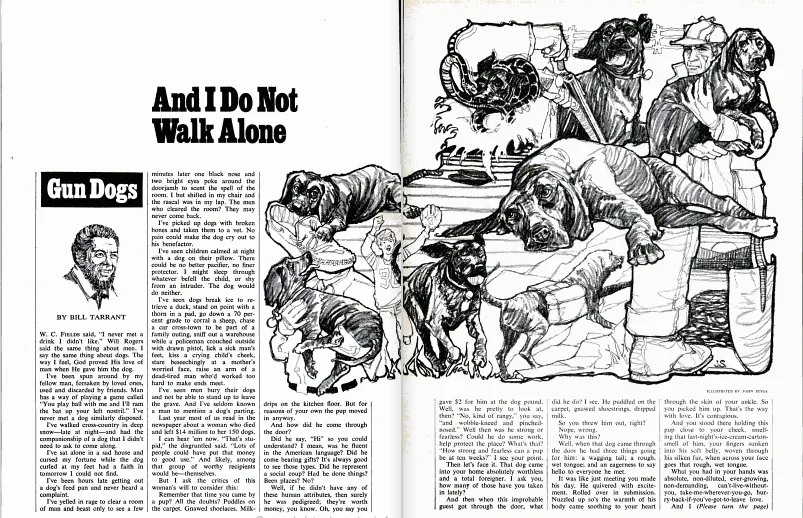
After it was published in 1974, “And I Do Not Walk Alone” generated an enormous, and emotional, response from readers. Field & Stream
A year passed, and the job remained open. Then lightning struck in the form of an unsolicited manuscript from a man who was a PhD, a former mayor of Wichita, Kansas, and the boxing and wrestling champion in his weight division of his Marine Corps division.
His name was Bill Tarrant. The article that he sent us was published in March, 1974, and it eventually got the title, “…And I Do Not Walk Alone.”
It’s celebration of dogs, and what they are to us. There was nothing as good written before, and it’s unlikely that it will be equaled, much less surpassed, in the future. Tarrant got the job. He wrote about people as much as he did dogs, and he did this until 1997, when he put his pencil down forever.
B
BOURJAILY, PHIL This is probably as apt a place as any to reveal that Phil Bourjaily
is the son of a famous man
of letters named Vance Bourjaily, so eminent that he is often mentioned in the same breath as Norman Mailer and Ernest Hemingway. Phil wrote his first piece for Field & Stream in the mid-1980s on snipe and snipe guns and snipe hunting, causing the editors who read his copy to say, “He’s good.”
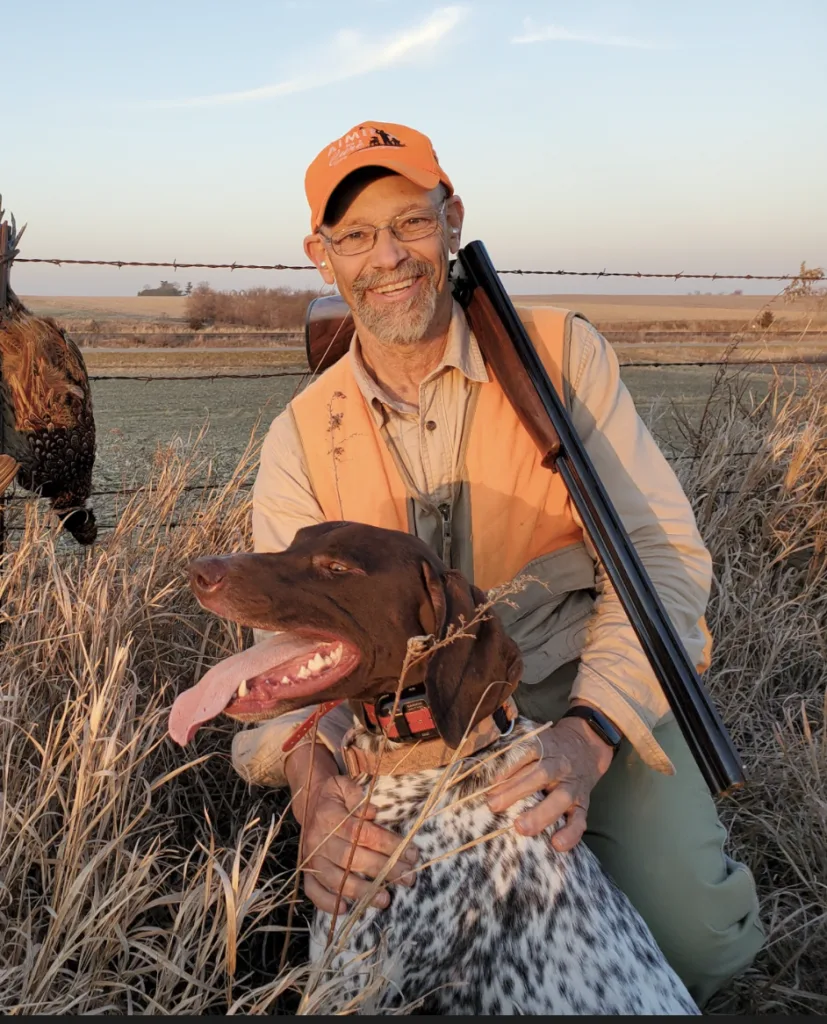
Phil Bourjaily has been writing about shotguns, hunting, and GSPs for F&S since 1995 Phil Bourjaily
And because he was good, a decade later he was made Regional Editor for the Midwest, seeing as he lives in Iowa, and was shortly thereafter elevated to Shotguns Editor, a post that he has held since 1995, and still causes the editors who read his copy to say, “How can he be that good all the time?”
It may be genetic. In the meanwhile, he is fond of German shorthair pointers
, and is very, very funny in a droll way. Droll is difficult to find these days.
If you read something Phil wrote, you will be smarter at the end of it, and you will ask yourself how he did it. We don’t know, either, but we’re damned glad he can do it.
BRISTER, BOB Uncle Robert
—that’s how he referred to himself—was Shooting Editor
of Field & Stream for 20 years or so and held up the shotgun end of things. Simultaneously, he was Outdoors Editor at the Houston Chronicle and when he retired, the newspaper declared him a Living Legend.
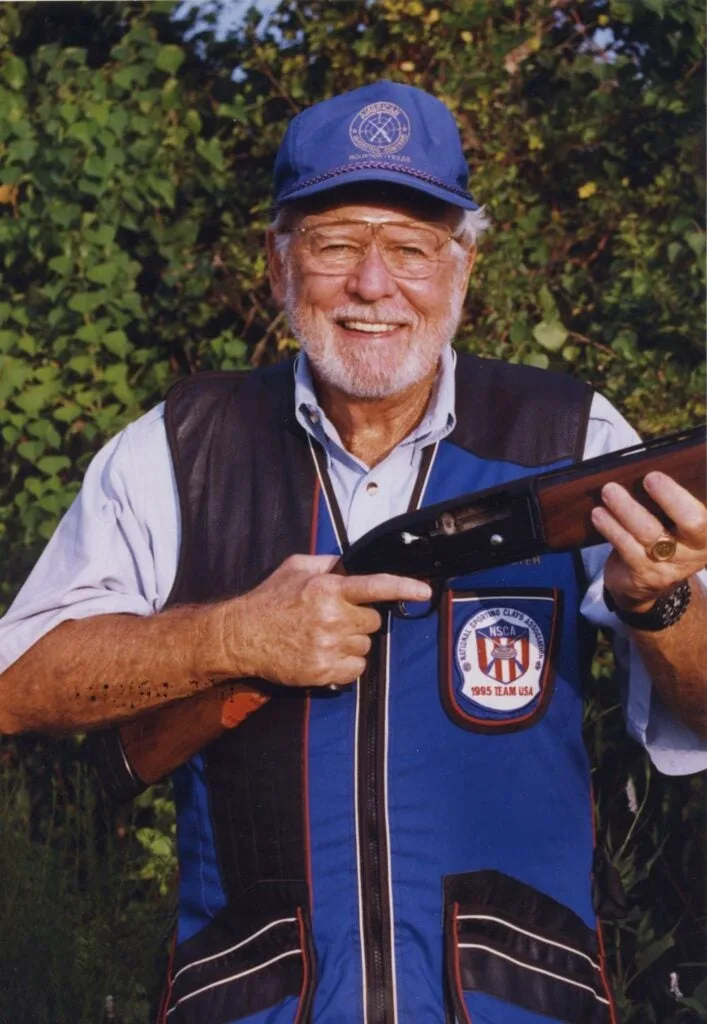
Long-time F&S shooting editor, Bob Brister. Field & Stream
Brister got the Field & Stream job in 1972. Not only was he a terrific writer and an all-around outdoorsman, but he was better than everyone else at whatever he set his hand to. He could also talk more than anyone except, possibly, Ted Trueblood. On the occasion where the two men met for the first time, it turned out that they were fans of each other and, as one awed witness put it, “They talked so fast that smoke rose.”
C
CAMP-FIRE-CLUB OF AMERICA One of America’s oldest hunting and fishing clubs, Camp-Fire
is comprised of roughly 450 members and has its permanent home on a New York State Forest Preserve in Westchester County, New York. Organized in 1897, the Club places a heavy emphasis on conservation through the Camp Fire Conservation Fund. Foremost among its ranks have been members such as Theodore Roosevelt
, Ernest Thompson Seton, and Buffalo Bill Cody.
For several decades in the early part of the 20th century, Field & Stream was “the official organ of the Camp-Fire Club,” which was comprised largely of members of New York City society. Over the years, nearly a dozen members of the Field & Stream staff have belonged to Camp-Fire, including three Editors in Chief. Its members are elected, and must have serious credentials not only as hunters and outdoorsmen, but as conservationists.
D
DILLER, PHYLLIS In 1973, Johnny Carson was the undisputed king of late-night talk shows, due in large part to a steady stream of gifted comedians who were regular guests. One of the most popular was Phyllis Diller, who was a trailblazer among female stand-up comics. Ms. Diller made fun of herself, her husband (whom she called “Fang”), her looks, and everything else about her life.
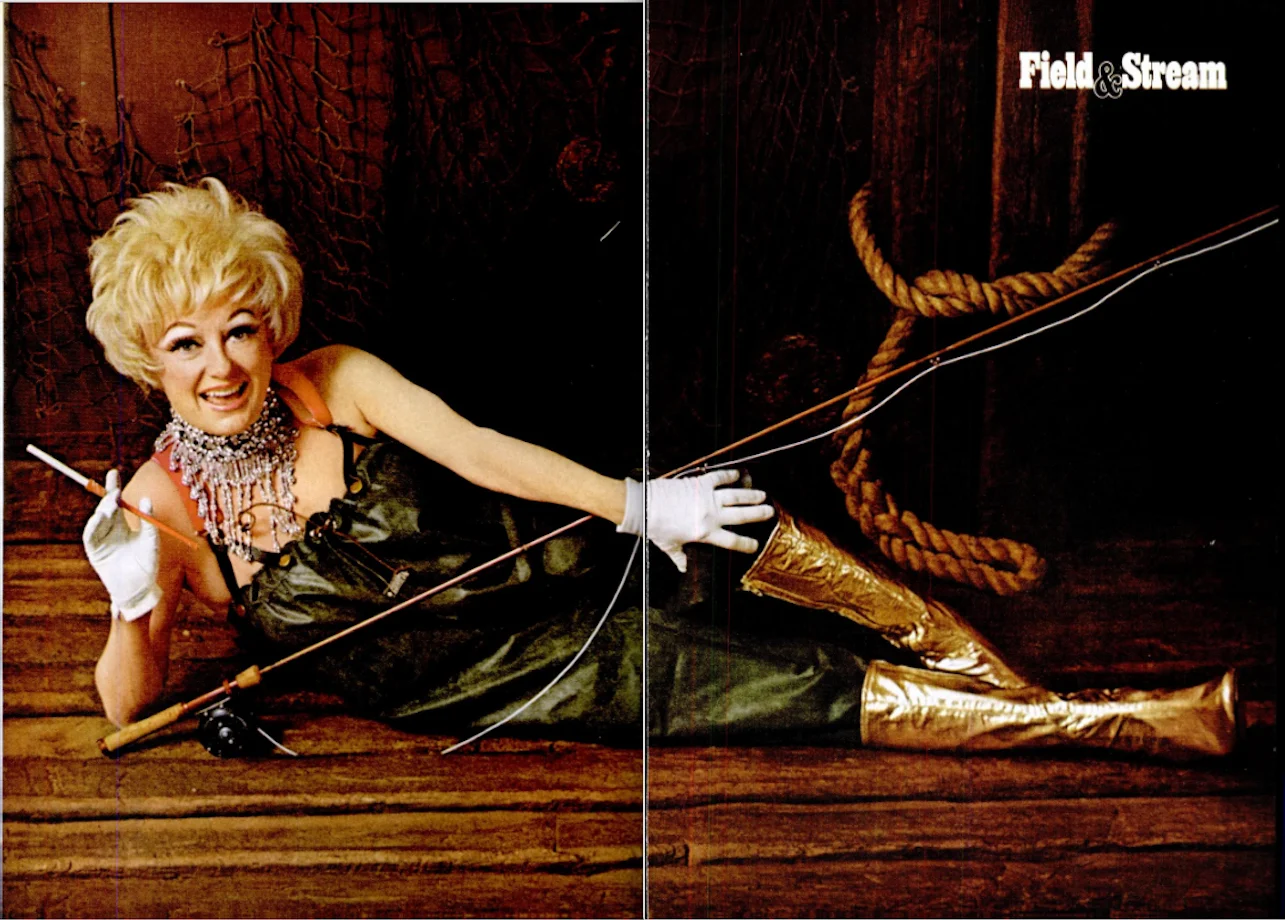
The first—and only—centerfold to appear in F&S. Field & Stream Archives
In 1973, magazine centerfolds were a big deal. Playboy started it, and then Cosmopolitan joined in by running centerfolds of Jim Brown and Burt Reynolds. Carson and Diller were talking about this one evening, and he asked her if she would be willing to pose as a centerfold, and if so, which magazine.
She paused, and said “Field & Stream.”
It brought down the house.
Among Carson’s watchers that night was a person who handled publicity for Field & Stream, who went to then Editor-in-Chief, Jack Samson, and proposed making Ms. Diller our centerfold for real. Samson loved the idea. It was proposed to Phyllis Diller, and she went for it.
The photo shoot took place on the roof of Abercrombie & Fitch, which was right across Madison Avenue. Ms. Diller wore black waders, a rhinestone choker, white gloves, gold lame boots, and had a fly rod resting against her recumbent form. The project was a mega-success. We milked it for all it was worth. So did Phyllis Diller. She was presented with a trophy (a very nice one) commemorating the occasion and went back on Carson to regale him with her career as an object of lust. She has been our only centerfold.
E
This may be the best thing Bob Brister ever wrote. Originally published in the June 1982 issue, it’s the story of an elephant hunt in the Chirisa Safari Area of Zimbabwe. Chirisa is a migration route for the jumbos from the Zambesi Valley to Hwange National Park.
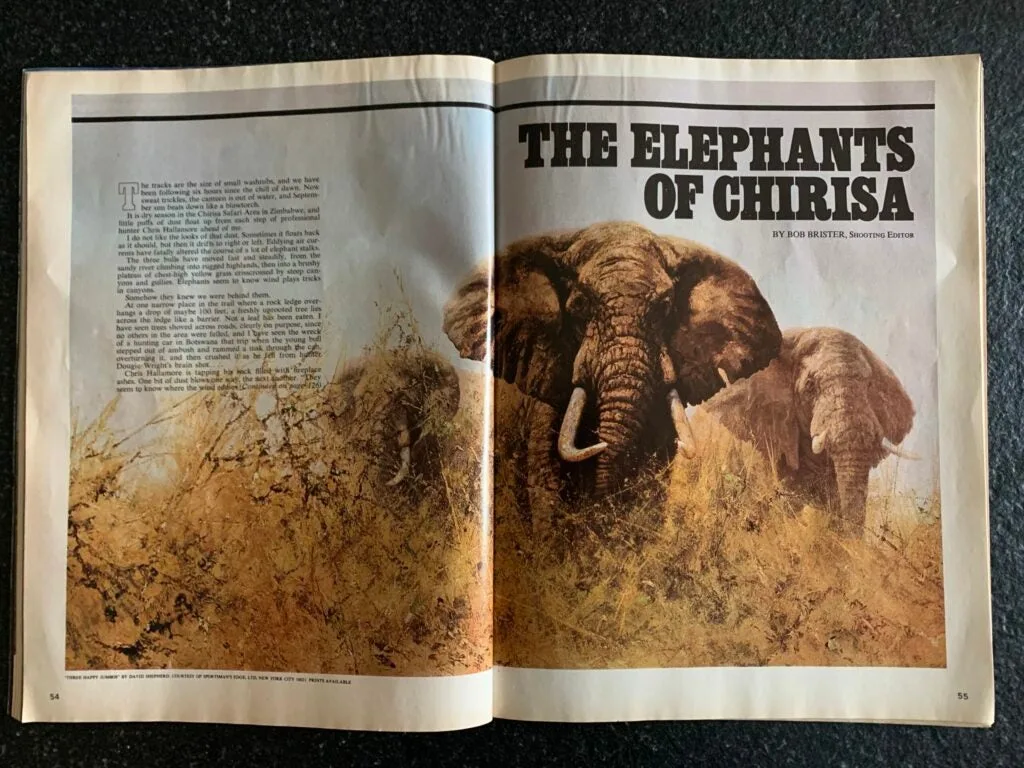
The Elephants of Chirisa was published in the June 1982 issue of F&S. Field & Stream
Hunting elephants is mostly walking. You may think you’ve gone on hikes before, but you haven’t until you try and overtake these creatures. And there is danger. Physically, at 6 tons, there’s nothing that can compare with an elephant, and it has several ways it can kill you—all backed by an intelligence that is just a click less than human. It’s not unusual for a PH to send his client back to the safari car in care of his head tracker while he decoys the herd away from them. At that point, it’s simply too dangerous to stick around.
Uncle Robert caught all this about as well as anyone ever has. And he got his elephant. And what he also got was guilt and regret—and admitted it, which at that time, very few people had the courage to do.
Brister’s last sentence was: “I don’t think I will ever kill another elephant.”
F
FORD, COREY Corey Ford
will always be associated with a column he wrote for the magazine called “The Lower Forty,” which chronicled the doings of a club comprised of small-town New Hampshire hunters and fisherman. It had a regular cast of seriously rural characters, and through the 1950s, and into the 1960s, it was one of the magazine’s most popular features.
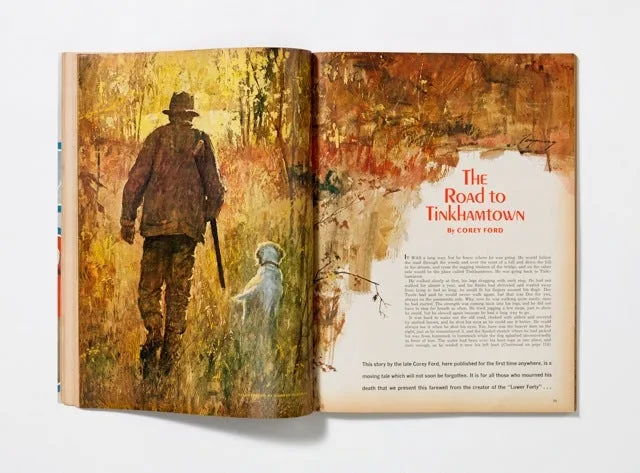
Corey Ford’s “The Road to Tinkhamtown” is one of the most popular stories F&S ever published. Field & Stream
Ford was the least likely of men to write something like this. The other magazines to which he contributed were The New Yorker and Vanity Fair. He was a member of the Algonquin Hotel’s Round Table, which was a collection of the leading wits in New York City, and it was Corey Ford who gave the name Eustace Tilley
to the top-hatted cartoon dandy that has been the trademark of The New Yorker for a century.
G
GUNS OF AUTUMN, THE On September 5, 1975, CBS-TV News aired one of the great smear jobs in the history of television, titled “The Guns of Autumn.”
It was narrated by Dan Rather, then a fair-haired boy at CBS. The show was an alleged expose of hunting and its many so-called abuses. Some of it was possibly true, but it was so one-sided that it was called out by even the Columbia University Journalism Review as a horrible example of how not to do a documentary that is fair and impartial.
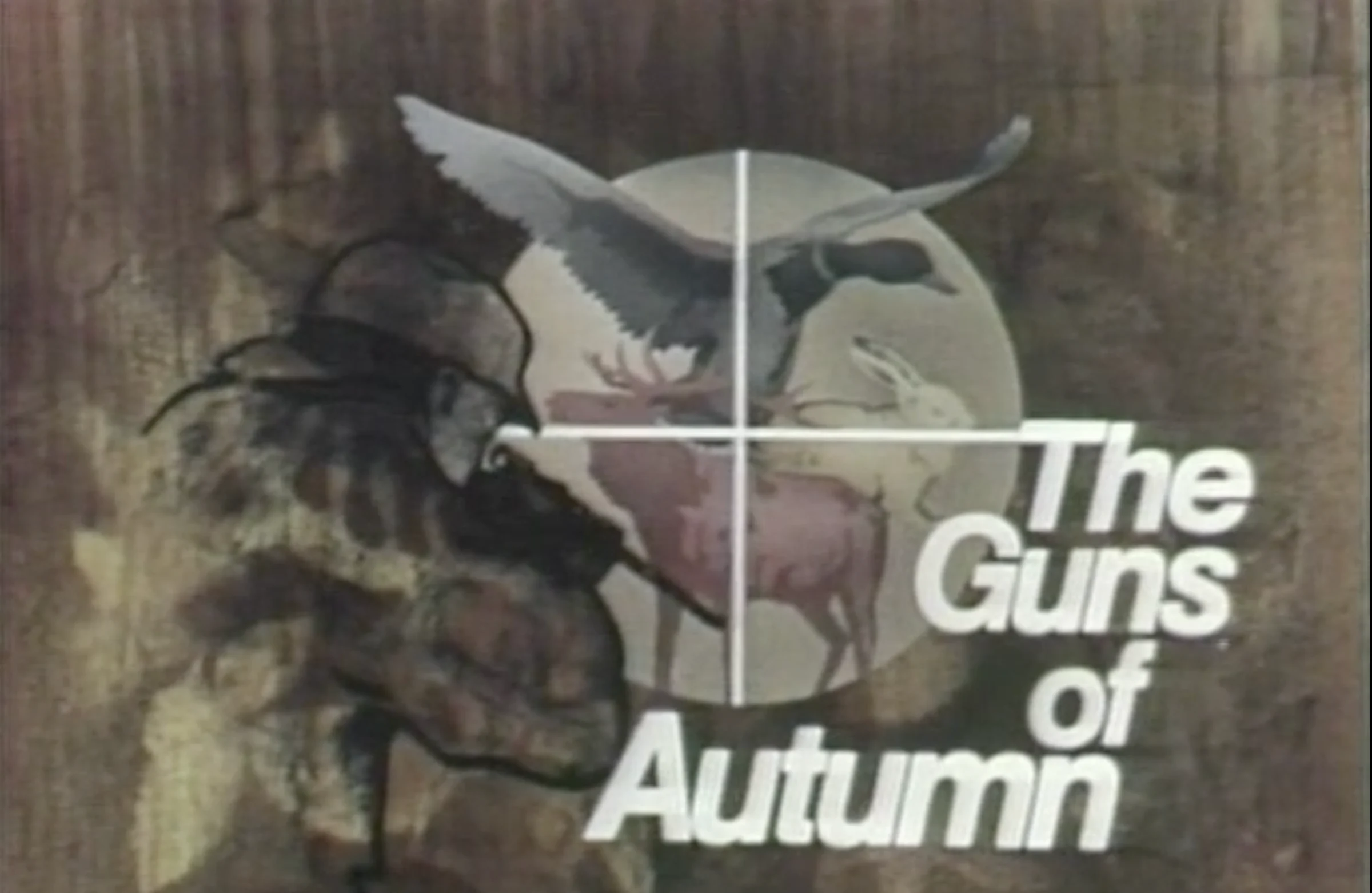
“The Guns of Autumn” aired on CBS in 1975. Vimeo
Field & Stream was at the time owned by CBS, Inc. and CBS-TV News was regarded as The Enemy (which indeed they were) by hunters and gun owners. The rumor spread that Field & Stream must also be part of the CBS propaganda machine, and the letters and phone calls began pouring in, along with subscription and advertising cancellations.
For months, Field & Stream’s editors probably devoted more time to answering outraged readers than they did to putting together the magazine. CBS took so much heat and lost so much money that since 1975, it has never again taken on the subject of hunting.
H
HILL, GENE Gene Hill
started with Field & Stream in 1977. He had a hold on people’s hearts like no one else. Hill fought on Okinawa in World War II, but he never mentioned it. He never even revealed that he was in the service. His military record came out only in his obituary.
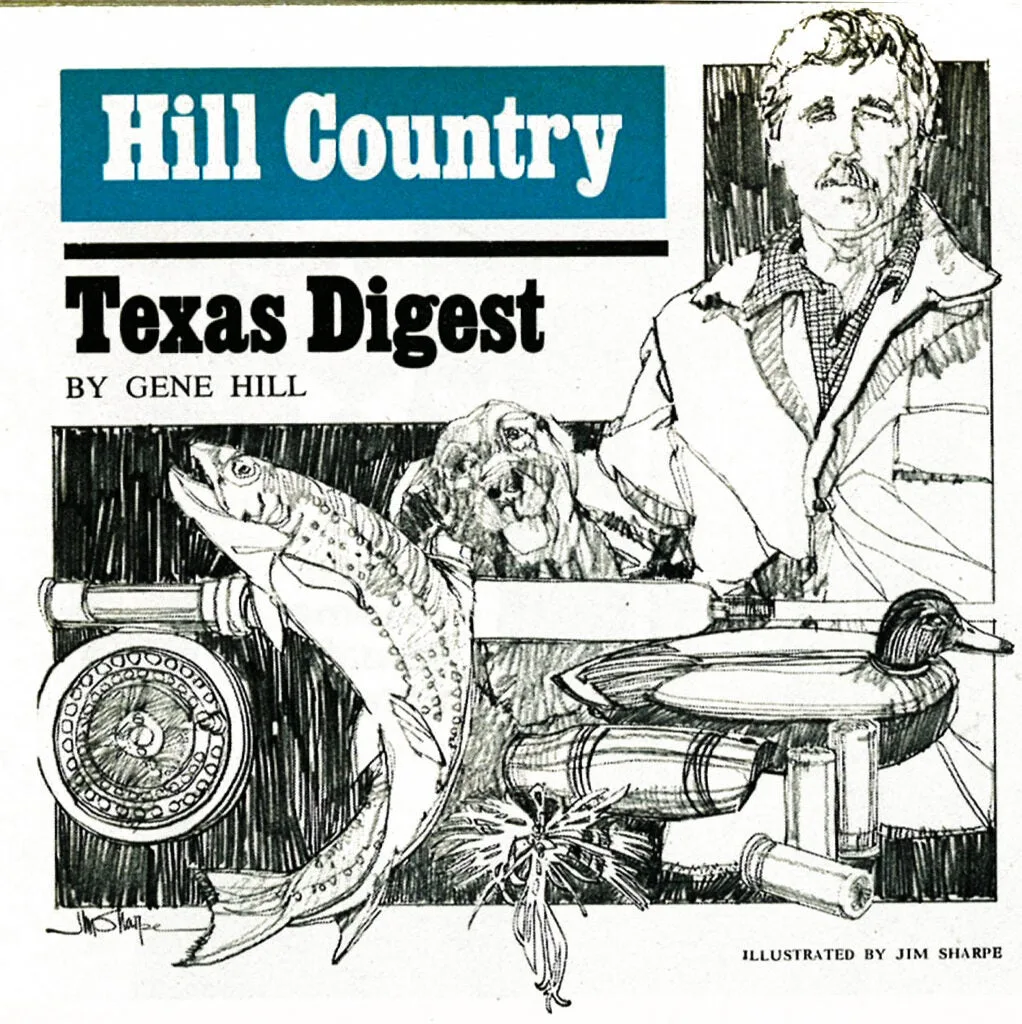
“Hill Country,” one of Field & Stream’s most popular columns, debuted in April 1977. Field & Stream
After the war, Hill graduated from Harvard and then went into the advertising business, but his heart was not there. He began writing about the things he loved, and eventually went to Sports Afield magazine as Executive Editor. But Field & Stream was where the major writers lived, so he joined us after a few years.
Hill numbered his friends in the hundreds, but it is a fact that he was somehow apart from everyone else. The people who knew him treated him with deference, more than anything else, because he had been given powers and insights that others lacked. If he were able to read this, he would laugh, but it is true nonetheless.
I
ISONYCHIA If you wish to be considered a serious fly fisherman, you must be able to identify the bugs that your flies and nymphs represent not in English, but in Greek and Latin. This can be burdensome. Or you can learn to say “Isonychia.” Isonychia
is a genus of mayflies, and includes just about every type of mayfly in existence. When trapped by entomologists bearing flyrods, resist the urge to panic. Remain silent, but every five minutes, say “Isonychia.” You will be accounted a wise man.
J
JAGUAR (PANTHERA ONCA) The largest cat native to the Western Hemisphere, the jaguar is fearsome feline that is also one of the rarest hunting trophies extant. It can adapt to a wide variety of wilderness; its range extends from Arizona through Mexico, Central, and much of South America.
The jaguar is the third largest cat in the world. At 300 pounds, the animal is twice the size of a big leopard, and is also the strongest cat, pound for pound. It has the most powerful bite of any feline species and is an excellent swimmer.
Hardly anyone has hunted jaguars in modern times. Gun writer John Wootters wore himself to a frazzle in southern Mexico trying to collect one, but never even got a glimpse. The most successful jaguar hunter of all time was a Latvian named Alexander “Sasha” Siemel, who killed 300 of the big cats in the 1930s, ’40s, and ’50s, and with a spear, no less. Siemel was a great favorite of the mens’ adventure magazines, and there were reams of copy telling of his many slaughters.
Currently, the jaguar is listed as Near-Threatened, mostly due to habitat loss. Luckily, it does not have Sasha Siemel to worry about any more.
K
KUDU, GREATER (TRAGELAPHUS STEPCISEROS) One of the premier African trophies, the greater kudu is possibly the twitchiest ungulate on earth. If a meerkat farts a mile away, it’s enough to send a whole herd of these antelope stampeding in terror. This is part of the kudu’s value as a trophy. Unlike roan and sable, which will stand there and pose for you, kudu will run like hell.
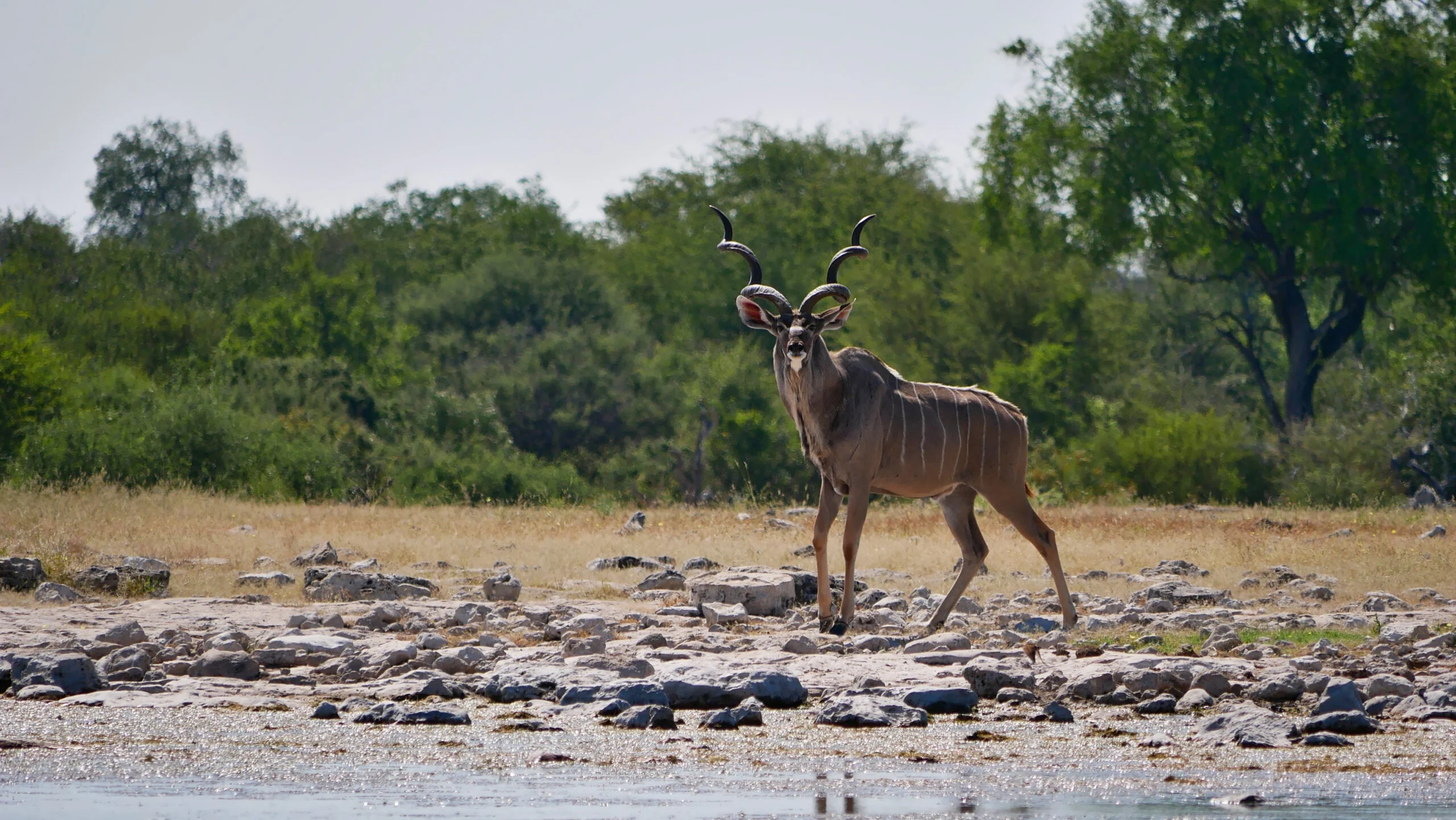
The greater kudu—of Africa’s most iconic trophies. Adobe Photostock
Robert Ruark had his kudu troubles. On his first safari, hunting with PH Harry Selby, he nearly killed himself trying to collect what Selby believed was a monster kudu bull. They had only glimpsed it, but Selby was certain it was the trophy of a lifetime.
After endless days of travail, Ruark killed the kudu, and one horn was indeed destined for the record book, but there was no other horn. The animal was a freak. Selby was nearly suicidal. Such is kudu hunting.
L
It’s no secret that the really great writers can make you wet yourself laughing or break your heart. That’s why Bill Heavey
, who has made people laugh for more than 20 years on the last page of Field & Stream, wrote what is probably the saddest story the magazine has ever run.

“Lilyfish” was first published in July 2000. Field & Stream
Entitled “Lilyfish,” it’s about every parent’s worst nightmare, the death of a child. Lilyfish was Heavey’s infant daughter, who passed away in 2000, and the story is the recounting of his efforts to endure the unendurable.
M
MERMAID A century ago, things were a lot more chaste then than they are now. So, what could have been the thoughts of readers when they beheld the cover of the February 1905 issue of Field & Stream, which showed an anatomically correct mermaid entangled in a net with what appears to be a redfish. And when we say anatomically correct, we mean correct.
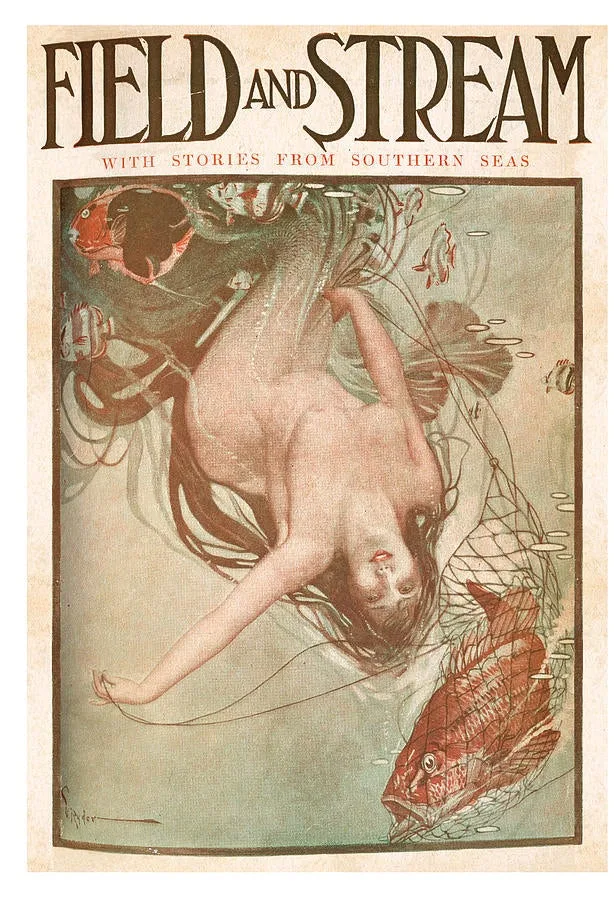
Of the hundreds of covers we produced over the years, this one is hands down the strangest. Field & Stream Archives
For the time, such an image was unthinkable, and it raises all manner of questions. How well did the cover sell? What were the cover meetings like? Were the editors bombarded with angry letters? Tried for indecency?
We’ll never know. Time has closed around the mysteries, and the sea around the mermaid.
N
NASH RAMBLER The Nash line of automobiles was produced from 1916 until 1954, when it became Nash-Kelvinator, and then was gobbled up by American Motors. After World War II, Nash produced a line of cars which, in a time of Detroit’s wretched excess and minimal quality control, were well made, sensibly sized, easy on gas, aerodynamic, and had seats that could be set up as beds. The Rambler was the most popular Nash and Ramblers were the first compact cars made in the United States

A 1956 Nash Rambler Cross Country station wagon. Did someone say, “road trip”? Adobe Photostock
In 1950, before he started “Exit, Laughing,” Ed Zern worked as a copywriter at the agency that created Nash advertising. Ed was friends with George Mason, who was president of American Motors and a rabid outdoorsman. One day, Ed wrote, Mason asked him why the stuff he wrote about hunting and fishing was so good and the ads he wrote about Nash automobiles were so dull.
“Because,” Ed answered, “your advertising department doesn’t approve the stuff I write about hunting and fishing.”
“Well,” said Mason, “do a half-dozen ads and give them to me personally.”
Ed wrote the ads in the absurdist style he would later use for “Exit,” added his hallmark cartoons, and even signed them. Mason loved it. Ed’s ads appeared in all sorts of magazines, and always in Field & Stream. More than 100 ran over nine years.
(Novelty songs were all the rage in the 1950s, and the Rambler, which was by then something of a cult car, had a song written about it called “Beep Beep,” sung by a group called the Playmates. The record went gold, and sold a million copies. It would be nice to say that Ed Zern had a hand in it, but he didn’t.)
O
In 1953, Field & Stream hired nationally-syndicated newspaper columnist Robert Ruark to write a monthly column titled The Old Man and the Boy. Ruark’s fee per column was $1,500 which, for the time, was unimaginable. But it was the smartest money the magazine ever spent. OMATB ran until November 1961, and established itself as not only the most popular work the magazine has ever published, but the most enduring.
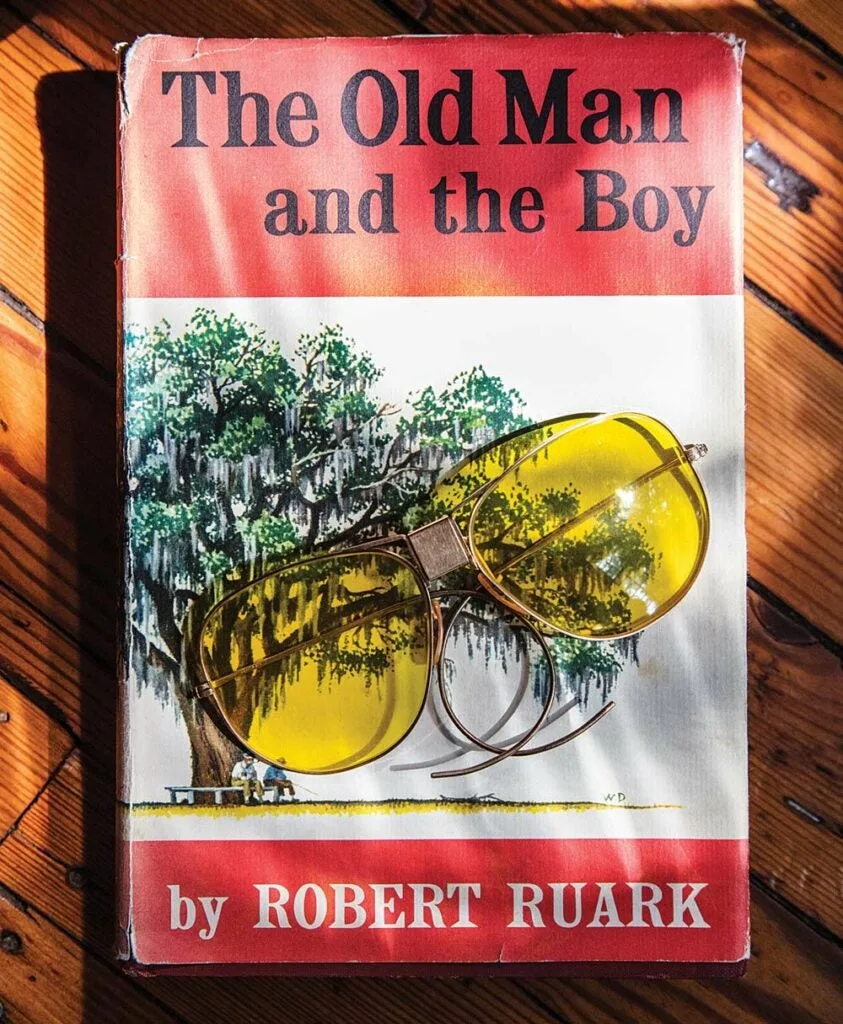
Robert Ruark’s “The Old Man and the Boy” columns were compiled into this timeless book. Cedric Angeles
Ruark’s family lived on the coast of North Carolina. As a kid, he received schooling in hunting, fishing, and life from two grandfathers whom Ruark combined into one character. It touched the readers such as no one has seen before or since.
Ruark himself was a tragic figure. He entered college at 15, found his trade early on as a newspaper reporter, and became an alcoholic while in his early 30s. He left the United States for good in 1960s, choosing to live the rest of his life in Spain. He loved Kenya, but he would never see it again. His two novels about the country had gotten him declared persona non grata. He drank himself to death in 1965 at age 49.
Ruark’s monument is not his gravestone in Spain, but his book, The Old Man and the Boy, which is a collection of his columns. It was first published in 1957. It’s still in print, and still selling. It will go out of print when there are no longer boys or old men who hunt and fish.
P

Petzal, alongside Judy, admires a mixed bag after a New Jersey bird hunt. David E. Petzal
PETZAL, DAVID E. David E. Petzal has been with F&S in one capacity or another since 1972. He started writing the Rifles column in 1981. Petzal has hunted all over the United States and in Europe and has taken many trips to Africa. He took up fly fishing very late in his life as a way to spend large amounts of money and aggravate himself in new ways. He has edited or written six books on guns and hunting.
Petzal and Norman Strung were born 15 minutes apart, Petzal in Manhattan and Strung in Brooklyn. They first met on an elk hunt in 1971.
Petzal’s first rifle coach was also captain of the Harvard rifle team.
His most memorable hunt was for elk in 1972. He lost 30 pounds in order to scramble around the mountains and got a 6-point bull, his first.
In college, he played mandolin in a bluegrass band and would have become a professional musician but for a lack of talent.
His boyhood hero was Warren Page.
Q
This article by T. Edward Nickens
ran in the April 2004 issue, and is about fly fishing in Labrador. We could have picked from among dozens and dozens of articles that Eddie has written for Field & Stream in over 20 years, because Eddie has hunted and fished damn near everywhere, writes about it better than just about everyone, and has mastered the unteachable art of taking the reader with him.
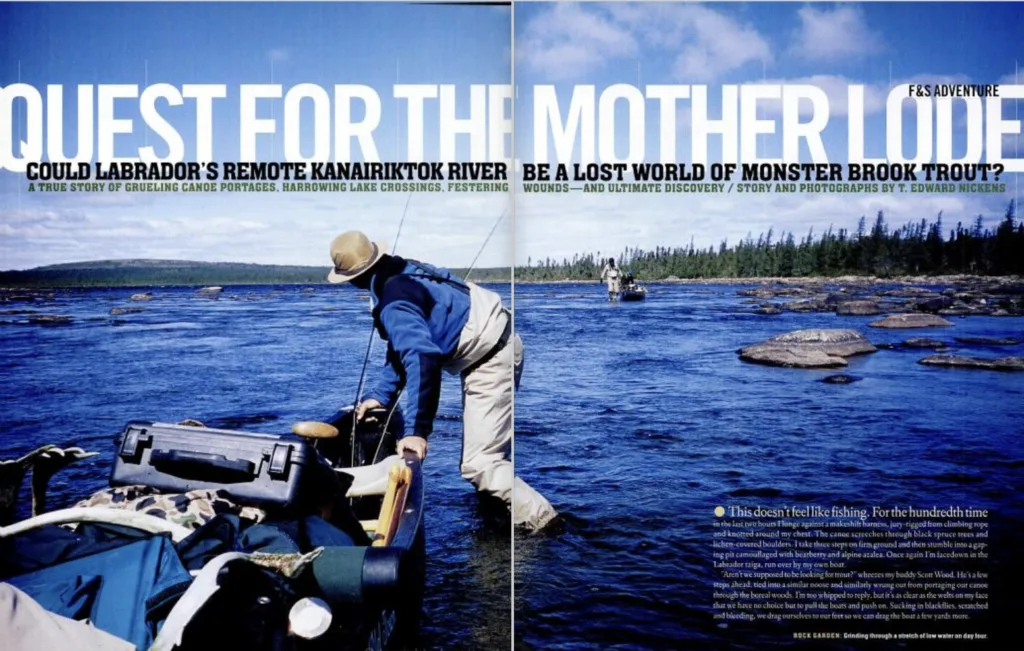
“Quest for the Mother Lode” was published in the April 2004 issue of F&S. Field & Stream
Take, for example, his description of Schefferville, a nearly-deserted mining town in the northern end of Quebec. Hell is a couple of steps up on the quality-of-life scale from Schefferville. His description of it goes thus: “This was Schefferville, where the sole recreational opportunity seems to be watching stray dogs chase windblown trash.” There you have the whole essence of the dreadful place in one short sentence.
Eddie studied journalism at the University of North Carolina, and obviously paid attention in class. He is a knife nut of the most depraved kind and is so short that, in his words: “When I wear a sheath knife the tip of the sheath drags along the ground.” He is also, in person, both charming and very funny.
R
REIGER, GEORGE Reiger came to the job of Conservation Editor in 1973 and lasted more than 20 years. In those two decades, he probably drew more hate mail, made more enemies, and was right on more issues than anyone who wrote about conservation in any other publication. If there were a survey taken for “Highest I.Q. Among Field & Stream Editors of All-Time” he would win going away.
The son of a country doctor who removed his tonsils at home on the kitchen table, Reiger graduated from Princeton University and went on to get a Masters in Literature from Columbia. He was commissioned in the Navy, sent to language school to learn Vietnamese, and was so good at it that he was made a translator at the Paris Peace Talks. Later, he taught English and boat-handling at the U.S. Naval Academy.
Today, when you hear of an environmental calamity, odds are George Reiger foretold it in the 1970s.
S
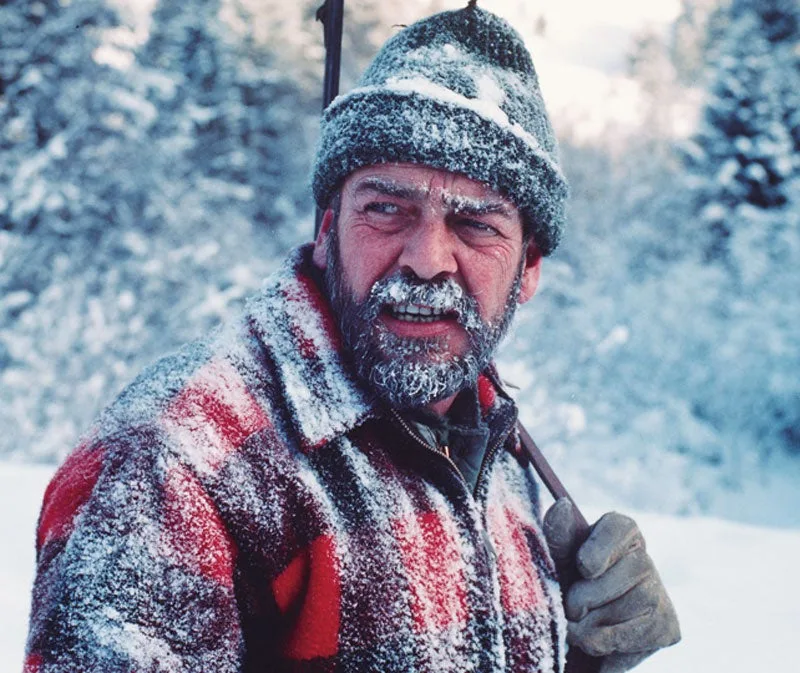
Norman Strung started contributing to F&S in the mid-1960s. Field & Stream Archives
STRUNG, NORMAN He began contributing to F&S in the mid-1960s when he was an English professor at Montana State University in Bozeman. One of our most eclectic contributors, he did everything from elk hunting to saltwater fishing. He was a highly disciplined writer whose output was prodigious, but he did not live to see his 50th birthday.
In his entire hunting career Strung used only two rifles—a Savage Model 99 lever action in .358 and a Browning BAR auto in .270.
He much favored Labrador retrievers, and he once wrote a column on the damage a Lab could do with its tail.
Strung hardly ever bought equipment. His wife, Sil, sewed his fly vest (it was a hideous blue color), and the couple did all their cooking on an ancient woodstove that they found and salvaged.
Born into a well-to-do family, Strung went to an exclusive prep school in the East. But instead of going on to college, he got on a train for Montana. When his father asked what he would do, he replied, “The best I can.”
T
He worked for Field & Stream from 1941 to 1982, and in that time established himself as a legend not only as a hunter and fishman, but as a conservationist.
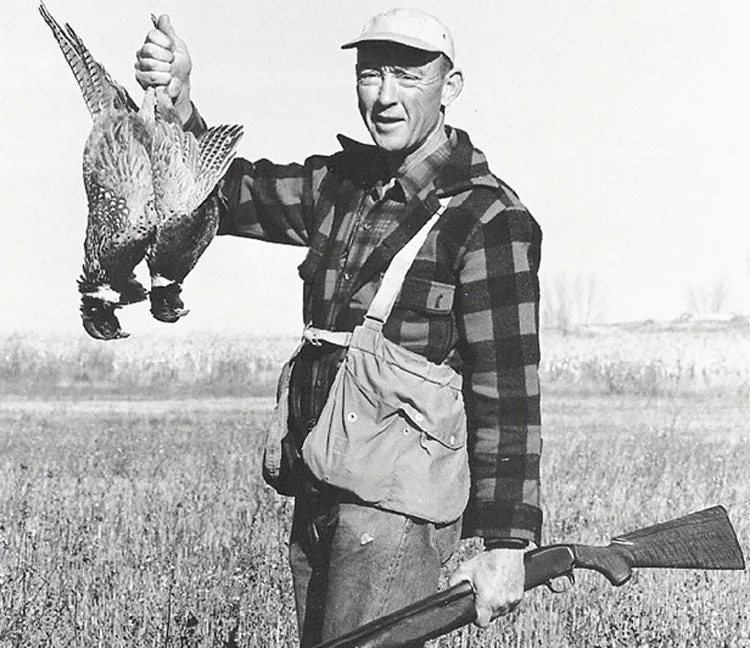
Ted Trueblood began his career at F&S in the early 1940s. F
Trueblood was so good at what he did that other Field & Stream editors, who were themselves masters of the trade, were unabashed fans and admirers. These included Bob Brister, Ed Zern, and Peter Barrett. He produced virtually perfect copy, and could make even the most mundane things fascinating. He once wrote a column on boxes
that you could not put down.
Trueblood solved problems creatively. Once, when he was away from home for several weeks, he returned to find a small mountain of mail on his desk. He set the mountain on fire. When his wife Ellen asked him if his bonfire would not create chaos and confusion, he said, “If it’s important, they’ll send another.”
His biggest problem was caused by Ed Zern who, in 1962, wrote an “Exit, Laughing”
column titled, “Is There Really a Ted Trueblood?” since many people assumed that the man, and the man’s name, were simply too good to be true. Zern’s conclusion was that “Ted Trueblood” was a myth concocted by the editors.
Ted instantly became an un-person, and spent months furiously denying the column. American Express canceled his credit card*. It took months to get his life back on track. Zern learned nothing from the experience, writing later that a consortium of wealthy Texas sportsmen was buying the state of Montana for their own use. Howls of outrage followed. Ed was delighted.
*In the late 1960s, Norm Strung applied for an AMEX card and listed his profession as “writer.” The application was turned down. He then reapplied, listing his trade as “carpenter,” which was also true. This time he got a card.
U
UNREALITY, COVER ART From the 1930s well into the 1960s, there was a trend in men’s magazines to take liberties with reality in their cover illustrations. This was seen most often in publications such as True, Argosy, Saga, and Man’s Life.* They would feature cover lines such as, “The mess on the floor was me,” and showed men who were built like Dwayne Johnson and women who looked like Margot Robbie in dire straits.

The May 1954 cover may not have been factually accurate—but it sure looked wild. Field & Stream Archives
Field & Stream was not immune to diddling with reality. The May 1954 issue showed a leopard in mid-air about to land on a baboon, presumably to kill it and eat it. There are a number of things wrong.
Leopards do love to eat baboons, but they prefer baby baboons which can’t fight back, and they hunt at night when the troop is asleep. One on one, a leopard can kill a baboon, but the fight is not going to be one on one. The baboon will defend itself with a set of enormous fangs that are bigger than the leopard’s and roar and bark at a volume that exceeds that of a train wreck. The rest of the troop will come running and tear the leopard to bits.
Leopards know this, so they don’t jump adult baboons in broad daylight. Probably the editor of Field & Stream knew it. However, the average American didn’t know it.
*One such magazine cover had a weird half-life. The September 1956 issue of Man’s Life showed a man up to his waist in water, shirtless, under siege by enraged weasels. The cover line read “Weasels ripped my flesh.” The future musician Frank Zappa saw the cover at the time and was fascinated by it. In 1969, he and his band, The Mothers of Invention, cut an album and titled it “Weasels Ripped my Flesh,” but instead of a shirtless guy, they commissioned an artist named Neon Park to paint a man in shirt and tie shaving with an enraged weasel and getting pretty badly nicked in the process.
V
V FOR VICTORY World War II consumed the pages of Field & Stream. Everything from ads to articles to covers dealt, one way or another, with the fight against the Axis. America was at war from December 1941, until August 1945, and for many months it was uncertain whether we would win or not.
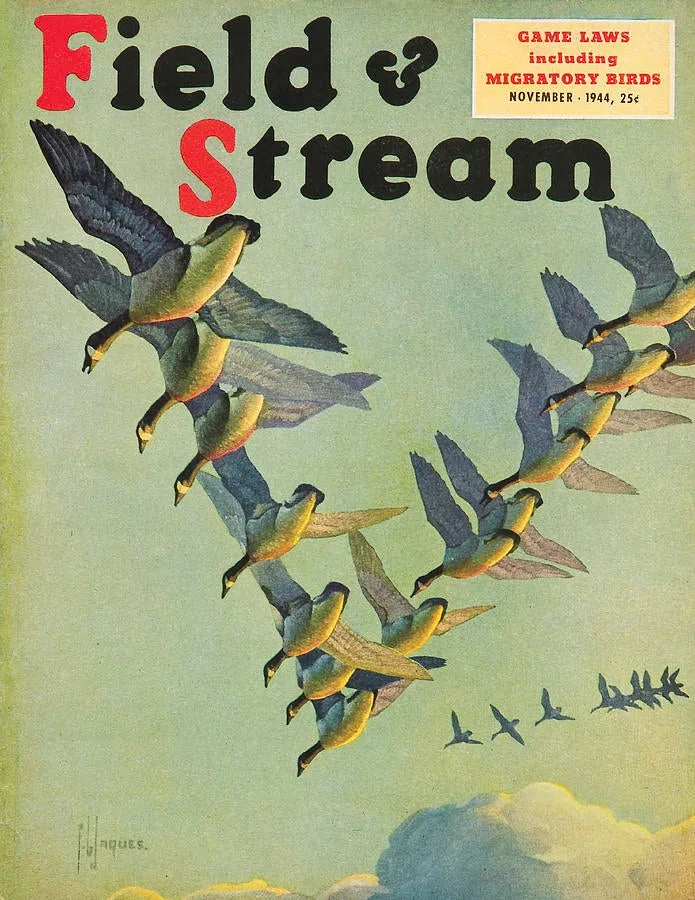
One of the most iconic covers in our archives called for victory during WWII. Field & Stream Archives
Throughout the war, the letter V had special significance. It stood for “Victory,” and Winston Churchill flashed the V sign whenever there was a camera around. In Morse Code, V is three dots and a dash. It is also the opening motif of Beethoven’s Fifth Symphony, three short notes and a long note, repeated twice. It was beamed by the British Broadcasting Company to Occupied Europe. V was everywhere.
W
WOOTTERS, JOHN In the early 1940s, Field & Stream hit on the idea of splitting its gun coverage between two writers: a shotgun guy and a rifle guy. There was simply too much for one person to cover. The first team was Col. Townsend Whelen, who was one of the all-time great riflemen, and one Bob Nichols, who was an expert on the fast draw and skeet shooting. Warren Page
unified the job of Shooting Editor in 1947, and held it until his retirement in 1971.
The torch was then passed to Bob Brister, but Uncle Robert already had a full time job with the Houston Chronicle and, in 1975, he asked that we get a rifle writer. The rifles chair went to John Wootters, another Texan, and a great gun writer in a time of great gun writers.
Wootters was not only an expert on rifles, but was probably the first writer to turn the hunting of whitetail deer into a science. When he wrote for us, his work week exceeded 100 hours, and his doctor told him to cut back or die, so he resigned in 1977. It was a shame. There was no one better, and precious few as good.
X
X-RING The X-ring is the exact center of the bull’s-eye. It originally dates to 1922, and was then called the V-ring. It was designed as a tie-breaking device for rifle matches. You would see scores like 599-8V, meaning that the shooter had gotten 599 points and put 8 bullets in the V-ring, and whoever got 599-7V could go eat his liver.
In 1967, the so-called SR target, which is still standard today, was introduced, and the V-ring was re-named the X-ring. Designations aside, there’s still no feeling quite like putting a shot in the exact center of the bull’s-eye.
Y
Yew The hardest of all the conifers, yew is a wood that has been prized for bowmaking since the Middle Ages, and is the symbol of a technology that has nearly vanished. For most of its history, Field & Stream dealt sparingly with bowhunting. Traditional tackle made it so difficult that only the most dedicated participated. Mastering a longbow or a recurve required endless practice, and even then, they were short-ranged and hard to hit with.
Archers who stuck with the sport became experts on woods. In addition to yew, osage orange was prized for bows, as was laminated bamboo. The best arrows were Port Orford cedar. They smelled wonderful when they snapped, which was often. Some shafts were “footed.” Heavy, strong, exotic woods such as wenge, purple heart, and bocote were spliced into the front of the shaft to give it added strength. Even the strings were organic. They were made of hemp, flax, or silk, and smart archers kept their strings waxed with beeswax, which kept the rain off.
Then, in the mid-1960s, the compound bow came along and changed everything. Using cables and eccentric pulleys, it had no connection to the natural world, but it was efficient in a way that no traditional bow could match. There are still yew bows, and people who hunt with them, but the compound is king.
Z
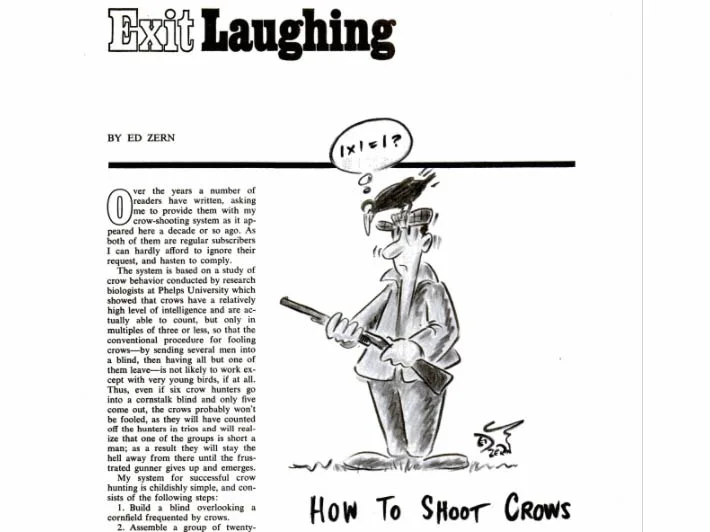
Ed Zern’s back-page column, “Exit, Laughing,” ran for more than 35 years, and “How to Shoot Crows” was him at his best—and most absurd. Field & Stream
ZERN, ED What else could the “Z” entry possibly be? A reserved West Virginian, Edward Geary Zern
was a humorist, cartoonist, hunter, fisherman, conservationist, and environmentalist. He departed this earth, having done his best to save some of it, in 1994, and he’s remembered primarily for his monthly column on the last page of the magazine titled “Exit, Laughing.” It was funny every month from the time it debuted in 1958, until the curtain fell more than 35 years later.
Being funny is the most difficult thing you can attempt. Being funny for that long is impossible. Ed did it anyway.

